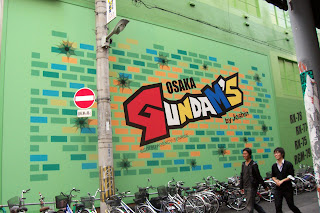
Yuki, the vocalist of the Oshare-Kei band, Anjyu', leads the audience in para-para. Anjyu' is part of a newer movement of Visual-Kei (which is basically Japanese glam rock) called Oshare-Kei, which is all about being cute, crazy, and colorful. This band was the headliner at a recent indie show in Umeda, Osaka.
Seeing Visual-Kei bands is something people can really only experience in Japan. I've seen some of the same bands in the States, but seeing them with a Japanese audience is pretty surreal. The entire audience does para-para (coreographed hand-dancing, for lack of a better description) and instead of cheering at the end of songs, everybody strikes poses. You don't see that sort of stuff in America!

The guitarist of SKULL has been playing with a broken index finger since October. I saw SKULL for the first time at Osaka Holiday in Umeda in October, and I was surprised to see him playing with a broken finger. And again, when I saw them in November, his finger was still broken. Despite that, he played great. It's nice to see guitarists with dedication like that. All the American bands I know who've had guitarists break their fingers normally just cancel shows until said guitarist's finger is healed. Interesting.
SKULL is a much different band than Anjyu'. They don't have much para-para and they're not really an Oshare-Kei band. Instead, they're pretty normal Visual-Kei, which is just outrageous hair, make up, and clothes.
(These photos were taken by my friend Laura at a show at Osaka Holiday that we went to. Do not steal them.)







